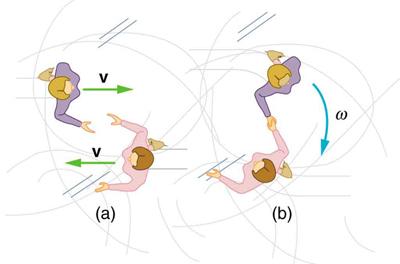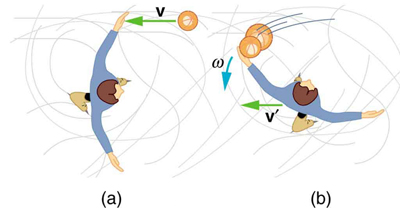| << Chapter < Page | Chapter >> Page > |
A cyclist pedals to exert a torque on the rear wheel of the bicycle. When the cyclist changes to a higher gear, the torque increases. Which of the following would be the most effective strategy to help you determine the change in angular momentum of the bicycle wheel?
(c)
An electric screwdriver has two speeds, each of which exerts a different torque on a screw. Describe what calculations you could use to help you compare the angular momentum of a screw at each speed. What measurements would you need to make in order to calculate this?
Why is it important to consider the shape of an object when determining the object's angular momentum?
(d)
How could you collect and analyze data to test the difference between the torques provided by two speeds on a tabletop fan?
Describe a rotational system you could use to demonstrate the effect on the system's angular momentum of applying different amounts of external torque.
A door on hinges is a rotational system. When you push or pull on the door handle, the angular momentum of the system changes. If a weight is hung on the door handle, then pushing on the door with the same force will cause a different increase in angular momentum. If you push or pull near the hinges with the same force, the resulting angular momentum of the system will also be different.
How could you use simple equipment such as balls and string to study the changes in angular momentum of a system when it interacts with another system?
Describe two different collisions—one in which angular momentum is conserved, and the other in which it is not. Which condition determines whether or not angular momentum is conserved in a collision?
Suppose an ice hockey puck strikes a hockey stick that lies flat on the ice and is free to move in any direction. Which quantities are likely to be conserved: angular momentum, linear momentum, or kinetic energy (assuming the puck and stick are very resilient)?
While driving his motorcycle at highway speed, a physics student notices that pulling back lightly on the right handlebar tips the cycle to the left and produces a left turn. Explain why this happens.
Repeat [link] in which the disk strikes and adheres to the stick 0.100 m from the nail.
(a)
(b)
(c)
Repeat [link] in which the disk originally spins clockwise at 1000 rpm and has a radius of 1.50 cm.
Twin skaters approach one another as shown in [link] and lock hands. (a) Calculate their final angular velocity, given each had an initial speed of 2.50 m/s relative to the ice. Each has a mass of 70.0 kg, and each has a center of mass located 0.800 m from their locked hands. You may approximate their moments of inertia to be that of point masses at this radius. (b) Compare the initial kinetic energy and final kinetic energy.

(a) 3.13 rad/s
(b) Initial KE = 438 J, final KE = 438 J
Suppose a 0.250-kg ball is thrown at 15.0 m/s to a motionless person standing on ice who catches it with an outstretched arm as shown in [link] .
(a) Calculate the final linear velocity of the person, given his mass is 70.0 kg.
(b) What is his angular velocity if each arm is 5.00 kg? You may treat the ball as a point mass and treat the person's arms as uniform rods (each has a length of 0.900 m) and the rest of his body as a uniform cylinder of radius 0.180 m. Neglect the effect of the ball on his center of mass so that his center of mass remains in his geometrical center.
(c) Compare the initial and final total kinetic energies.

Repeat [link] in which the stick is free to have translational motion as well as rotational motion.
(a) 1.70 rad/s
(b) Initial KE = 22.5 J, final KE = 2.04 J
(c)

Notification Switch
Would you like to follow the 'College physics for ap® courses' conversation and receive update notifications?